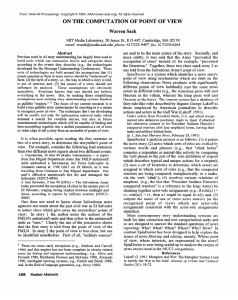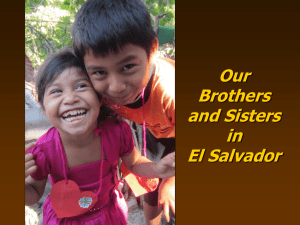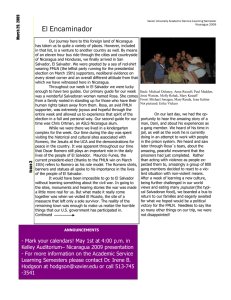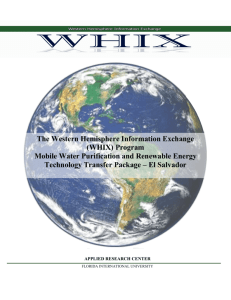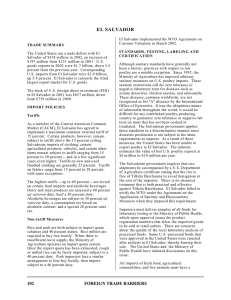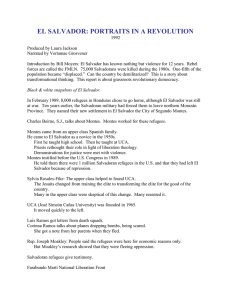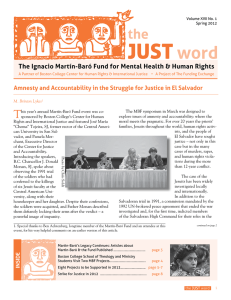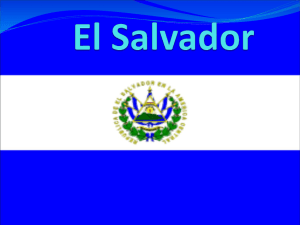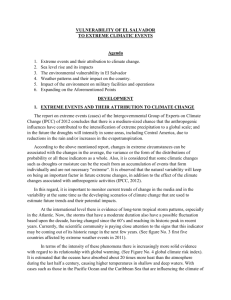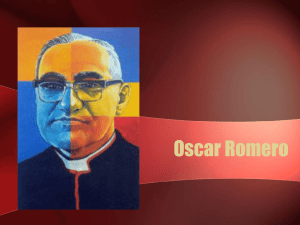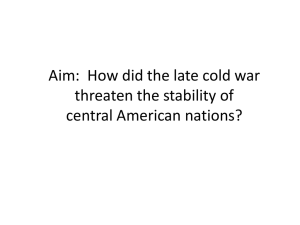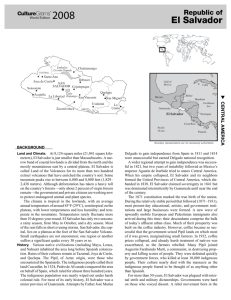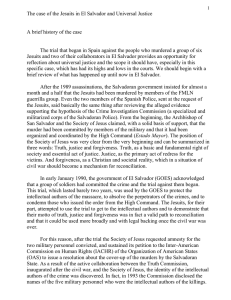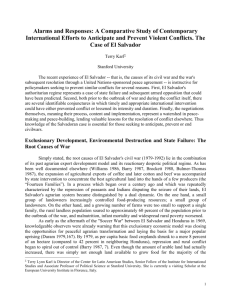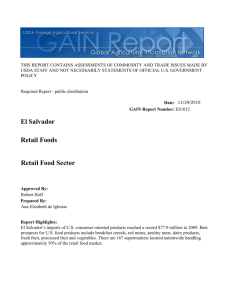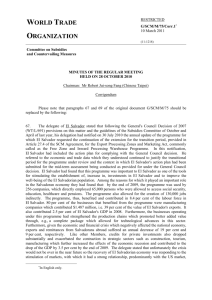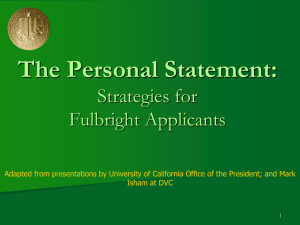Civil War in El Salvador
advertisement
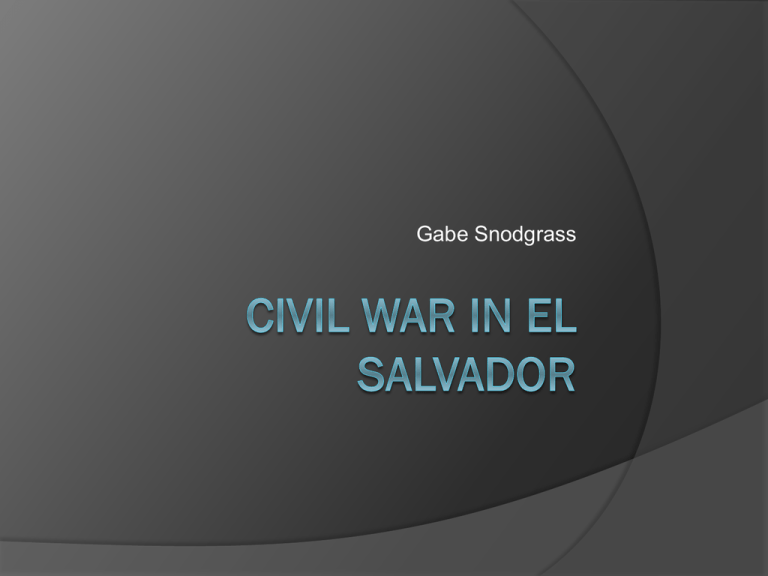
Gabe Snodgrass El Salvador Located in Latin America (next to Honduras and Guatemala) Key Players Civil war between military-led government of El Salvador and Farabundo Marti National Liberation Front (FMLN) Background Before the war started in 1980, there had been violence and tension between the rich and poor Frustration from the lower class started when coffee became a major crop for El Salvador 95% of El Salvador’s income came from coffee but all of this money went to about 2% of the people Background cont. In 1932, Augustin Farabundo Marti formed the Central American Socialist Party and led peasants against the govt. The El Salvadoran military and death squads killed about 30,000 of those people Marti was arrested and executed Events leading up to Civil War With the guerilla forces becoming more and more relevant, the govt. brought back the death squads to fight the rebels In 1979, rebels overthrew the El Salvadoran government. However, they failed to do what they promised Because of this the FMLN was formed Start of the Civil War Officially began in 1980 The military killed anyone suspected of supporting the revolution Often clergy, teachers, unionists, or independent farmers Death Squads Known during the war as Escuadron de la Muerte or “Squadron of Death” Became well known after killing Archbishop Oscar Romero in 1980 Later that year, 3 nuns and a lay worker were raped and murdered Death Squads cont. Wiped out entire villages Along with the rest of the El Salvadoran military, death squads were funded by U.S. All attacks by death squads were denied by El Salvadoran govt. and U.S. During the War Soon after the murder of Archbishop Romero, peaceful rallies became violent as the military fired into the crowds of unarmed people At this point, the civil war was receiving international attention FMLN Used strategy by destroying coffee plantations, bridges, cut power lines and anything else that supported the military To return the favor, the FMLN kidnapped and murdered government officials Made advancements in weapons as the war went on Refused to attend presidential elections Near the End All the countries resources were exhausted from both sides Since the U.S. aided the military with weapons and money, they were able to continue fighting The End Fighting left 75,000 people dead, most of which were peasants and innocent people Lasted 12 years (1980-1992) U.S. Involvement Supplied El Salvadoran military with funds and weapons Temporarily cut funds after nuns were killed in 1980 but proceeded after Ronald Reagan took office At the height of their aid, U.S. supplied $1.5 million to the government Cut funds in 1990 after UN got involved Debate still goes on today as to whether it was okay for the United States to support the military Video Clip http://www.youtube.com/watch?v=TixMb RPMcfg&feature=related Work Cited Christine J. "El Salvador: Contradictions of Neoliberalism and Building Sustainable Peace." Web. "Civil War in El Salvador." Nova Online Home Page. Web. 18 Sept. 2011. <http://novaonline.nvcc.edu/eli/evans/his135/Events/ElSalvador80/Salvador80.html>. this site will be used for more background information. "El Salvador: 1945-92." MacroHistory : World History. Web. 18 Sept. 2011. <http://www.fsmitha.com/h2/ch24salvador.htm>. this site will be used for information on the events leading up to the start of the war. "El Salvador Civil War." GlobalSecurity.org - Reliable Security Information. Web. 18 Sept. 2011. <http://www.globalsecurity.org/military/world/war/elsalvador2.htm>. this site will be used for info on some events that happened during the time of the civil war. "Enemies of War - El Salvador: Civil War." PBS: Public Broadcasting Service. Web. 18 Sept. 2011. <http://www.pbs.org/itvs/enemiesofwar/elsalvador2.html>. this site will be used for information on why and how the U.S was involved. Gammage, Sarah. "El Salvador: Despite End to Civil War, Emigration Continues." Migration Information Source. Web. 18 Sept. 2011. <http://www.migrationinformation.org/Profiles/display.cfm?ID=636>. this site will be used for info on the immigration of El Salvadorians to the United States. "Peace and Conflict Monitor, US Influence in El Salvador's Civil War." Peace and Conflict Monitor. Web. 18 Sept. 2011. <http://www.monitor.upeace.org/innerpg.cfm?id_article=591>. This site will be used for information on U.S involvement in the war and their influence. "Salvadoran Civil War." Wikipedia, the Free Encyclopedia. Web. 18 Sept. 2011. <http://en.wikipedia.org/wiki/Salvadoran_Civil_War>. This site will be used for basic background info on the civil war. "War in El Salvador." University of Michigan. Web. 18 Sept. 2011. <http://www.umich.edu/~ac213/student_projects07/transgang/war.html>. this site will be used for the causes and effects of the civil war. Work Cited cont. http://owenfranken.photoshelter.com/galleryimage/Walls/G0000Zimm7TsMBI8/I0000cup2GE8lbfg http://www.newint.org/features/2005/12/01/powerpolitics/ http://milpubblog.blogspot.com/2011/01/aar.html http://www.hrc.utexas.edu/press/releases/2007/elsalvador.html http://www.seniorreligion.com/30th_anniversary.htm http://www.cathnewsindia.com/tag/spain/ http://www.contactpressimages.com/portfolios/rebbot/rebbot_po rtfolio6.html http://www.socialistworker.co.uk/art.php?id=5333 http://www.freedomarchives.org/La_Lucha_Continua/Farabund o_Marti.html http://centralamericanpolitics.blogspot.com/2010/11/fmln-in-elsalvador.html http://www.cja.org/article.php?list=type&type=199 http://www.returntoelsalvador.com/blog/117

